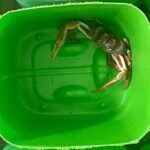It is hard enough to protect any species, but when you don’t even know where they are or which way they go the task can become impossible. This problem is one facing Common Nighthawks—a migratory bird whose populations have been declining for many years. We know that Common Nighthawks breed across North America during the spring and summer, but the details of exactly where they go in winter have eluded scientists. Thanks to new tagging technology, which collected some exciting migration data published in the Canadian Journal of Zoology, we are now starting to build a picture of where these enigmatic and threatened birds are going.
To solve the mystery of where nighthawks overwinter, lead author Janet Ng and her colleagues at the University of Alberta and the Smithsonian Migratory Bird Centre attached GPS tags to 10 nighthawks. Tags used to track birds usually archive location data inside the tag itself, and the bird must be recaptured to retrieve the data, which can be challenging. For this study, however, the team used a tag that sends the data up to a satellite then to a server for the researchers to download. Although more expensive, these tags gave what co-author Elly Knight describes as an “unprecedented data return rate for this kind of work”—with some very interesting results. “We were a little surprised at where they went” Knight concluded. In winter, Common Nighthawks have been spotted as far south as northern Argentina, but the data from tagged birds—all of which came from breeding areas in Alberta, Canada—showed nighthawks only went as far south as central Brazil.
Tagging a Common Nighthawk is no walk in the park. First the researchers need to locate a male or two. Then they need to catch them with mist nets, which are fine, nearly invisible nets suspended in the air. “The idea is that the birds can’t see the netting and so they fly into the net and get caught” Knight explained. The trouble with nighthawks is that their big eyes that dwarf their tiny beak gives them excellent sight for hunting insects in low-light conditions, which means they can also see the mist-nets: “I have many observations of them flying around the net, perching on the net, and sitting on the ground next to the net”. To capture the birds, the researchers had to think a little more strategically.
Enter Maurice—a particularly attractive male nighthawk not made of feathers but of corrugated plastic placed inside the mist nets and accompanied by sounds of a calling nighthawk from a nearby speaker. “[The nighthawks] just get so angry about Maurice and all the sounds Maurice is making, that they fly around and around and eventually they make a mistake and get caught in the net trying to get at Maurice”, Knight enthused.
With this study being so successful, Knight is now leading a larger tagging project involving 11 nighthawk populations across North America and a huge team of collaborators. The information they gain will be invaluable in identifying where the birds are threatened by habitat loss and increasing agricultural development, which uses pesticides that kill the insects the nighthawks feed on.

Janet Ng holding Maurice.
Read the full paper: First full annual cycle tracking of a declining aerial insectivorous bird, the Common Nighthawk (Chordeiles minor), identifies migration routes, non breeding habitat, and breeding site fidelity in the Canadian Journal of Zoology.




